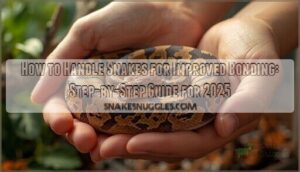This site is supported by our readers. We may earn a commission, at no cost to you, if you purchase through links.
Most people imagine snake handling as a nerve-wracking test of courage, but the real secret is in the quiet moments—when a ball python settles into your palm, muscles relaxed, tongue flicking curiously. Bonding with a snake isn’t about dominance or bravado; it’s about trust built through careful steps and subtle cues.
If you’ve ever watched a snake glide effortlessly across its enclosure, you know how sensitive they are to touch, temperature, and routine. Mastering snake handling for improved bonding means tuning into these details, creating a safe space, and learning the art of gentle interaction—so both you and your snake thrive together.
Table Of Contents
- Key Takeaways
- Preparing a Safe Snake Handling Environment
- Choosing The Right Tools for Handling
- Approaching and Picking Up Your Snake
- Interpreting Snake Body Language
- Step-by-Step Handling Techniques for Bonding
- Building Trust and Positive Associations
- Monitoring Progress and When to Seek Help
- Frequently Asked Questions (FAQs)
- How do you handle a snake if you’re nervous?
- Is it safe to hold a pet snake?
- Can a snake be held too tight?
- How do you build trust with a snake?
- How do you handle a pet snake?
- Is it safe to handle snakes?
- Can snakes recognize individual handlers by scent?
- How does handling affect snake brain development?
- Do snakes benefit from enrichment outside handling sessions?
- What impact does handling have on snake conservation attitudes?
- Conclusion
Key Takeaways
- Successful snake bonding relies on reading body language and respecting individual boundaries, with handling sessions starting at 5 minutes and gradually increasing as trust builds through consistent, gentle interaction.
- Environmental setup matters as much as technique—secure enclosures with proper temperature gradients (75–85°F), humidity control, and strategic hiding spots reduce stress and create the foundation for positive handling experiences.
- Species-specific behavioral cues require different approaches, with some snakes like corn snakes developing scent recognition of handlers while others like ball pythons may not, making it essential to adapt your methods to your individual snake’s temperament.
- Persistent stress signals including chronic hiding, reduced feeding, and elevated heart rates indicate when professional consultation is needed, as most handling injuries stem from ignoring these warning signs rather than from the snakes themselves.
Preparing a Safe Snake Handling Environment
Before you start handling your snake, it’s important to set up a space where both you and your pet feel secure. The right environment makes all the difference in keeping stress low and safety high.
Let’s look at what you’ll need to get started.
Choosing Secure Enclosures
Regarding creating a comfortable snake habitat, your secure enclosure matters most. Choose escape-proof materials like PVC, and always use lock mechanisms—clips or padlocks—to keep your snake safe.
Size requirements are clear: the enclosure should match your snake’s full length for healthy movement. Ventilation safety and regular maintenance protocols are essential for a stress-free, escape-proof snake habitat.
Regularly inspect the room for potential escape routes to make certain your snake remains safe.
Maintaining Optimal Temperature and Humidity
Once your snake enclosure is secure, you’ll want to focus on temperature gradients and humidity control. For healthy snake care, keep the habitat between 75–85°F, and monitor humidity daily—too low, and shedding issues pop up; too high, and respiratory health suffers.
Snakes, being ectothermic reptiles, rely on external heat sources to thrive. Environmental monitoring with thermometers and hygrometers helps you fine-tune reptile care, keeping your snake healthy and stress-free.
Providing Appropriate Hiding Spots
After you’ve set the right temperature and humidity, think about hiding spots. Your snake’s comfort depends on secure hides—choose natural materials and cover 25–30% of the enclosure floor. Place hides at both ends for thermal gradient access.
Juveniles acclimate faster when hides are available. Vertical hide options encourage natural snake behavior, supporting better snake health and overall snake care.
Minimizing Stressors and Distractions
After arranging good hiding spots, your next focus is shaping a stress-free environment. Environmental predictability works wonders: limit noise pollution and steady your movements. Avoid sudden movements, bright light intensity, or strong handler scent, as each can spark defensive body language or disrupt gentle handling. Watch for these triggers:
- Sudden movements or jerky gestures
- Loud noises
- Harsh lighting
- Strong human scent lingering nearby
Choosing The Right Tools for Handling
Having the right tools makes handling your snake safer and less stressful for both of you. Some options work better in certain situations or with different species.
Let’s look at what you’ll want to have ready before you get hands-on.
Selecting Suitable Snake Hooks
Looking for a reliable snake hook? Focus on hook material—carbon fiber for strength, stainless steel for durability, or lightweight aluminum to reduce fatigue. Hook length matters: 40–45 inches gives control with both shy and strong snakes.
Ergonomic design, like a secure rubber grip, boosts daily comfort and safety impact.
Quality snake hooks cost more, but longevity and peace of mind easily outweigh the price.
When to Use Paper Towel Rolls
During medical observation or quarantine, paper towel rolls excel as a substrate—think easy hygiene benefits and fast disease detection. For your pet snake, they’re especially useful in a stress-free environment, letting you spot mites or abnormal waste quickly.
Non-burrowing species thrive with this setup, but watch for safety concerns during feeding, since accidental ingestion can happen in a snake enclosure.
Proper Use of Protective Gear
From gloves to gaiters, your gear matters. Choose glove material that blocks bites, and always check eyewear standards—especially with spitting cobras.
Gaiter effectiveness is proven for lower-leg protection; don’t skip them in tall grass.
Stick to protocol adherence: inspect gear often, replace when worn, and use protective clothing every time. These safe handling techniques are key for snake safety and bite prevention.
Approaching and Picking Up Your Snake
Before you scoop up your snake, how you approach matters just as much as what you do next. Let’s look at the right ways to move in and make those first moments calm for both you and your pet.
Here’s what to keep in mind as you get ready to pick up your snake.
Approaching From The Side
Ever wonder why snakes freeze or dart away when you swoop in from above? Approaching from the side dramatically reduces startle responses, minimizes bites, and encourages natural exploration. By adapting your handling techniques to mimic how another animal or branch might approach, you signal safety, building confidence and laying the groundwork for long-term bonding through positive snake behavior and clear body language.
Approaching your snake from the side reduces startle reactions, builds trust, and sets the stage for confident, positive handling
- Reduce startle flights
- Minimize accidental bites
- Encourage trust and exploration
Using Gentle Touch to Initiate Contact
Start your snake interaction with a gentle touch—think of it as an introduction in a world where tactile sensitivity shapes trust. Snakes respond better to slow, light contact along the body, which reduces defensiveness and jump-starts handler recognition.
Short, consistent sessions—less than ten minutes—help you gauge species variability and set the stage for lasting snake bonding through gentle handling.
Supporting The Snake’s Body Correctly
Think of your snake as a living rope—if you let it dangle from one end, you risk real harm. Proper Body Support isn’t just a Safety Precaution; it’s the backbone of good Handling Techniques.
For safe Snake Restraint, always:
- Use two hands, spaced apart
- Support the belly and tail
- Let the snake move through your hands
- Never grab by the neck or tail
Avoiding Sudden Movements and Common Mistakes
Once your hands are in position, focus on Sudden Movement Prevention. Abrupt gestures can spike stress and trigger defensive postures—veterinary logs link 27% of bites to this.
Gentle Handling Techniques, like moving slowly and watching body language, help with Handling Error Reduction.
Develop a Movement Protocol: approach from the side, avoid distractions, and always read your snake’s behavior for effective Snake Stress Management.
Interpreting Snake Body Language
Reading your snake’s body language is key to safe, positive handling. You’ll want to spot relaxed behaviors and catch signs of stress before they become a problem. Here’s what to look for as you get to know your snake’s signals.
Recognizing Calm and Relaxed Behaviors
Comfort is written all over a snake’s body language. You’ll notice a fluid body posture, with slow movements and steady tongue flicking. When your snake explores calmly or stretches out, it’s showing trust.
Social buffering—like a companion snake—can help maintain calm, letting heart rates return to baseline quickly. These behaviors signal successful handling and bonding.
Identifying Signs of Stress or Discomfort
When Snake Behavior shifts from relaxed to tense, you’ll spot clear Stress Signals. Watch for:
- Coiling tightly or freezing in place
- Hissing or mock-striking
- Persistent escape attempts—pushing at enclosure walls
- Over-alertness, like rapid tongue flicking
These Physiological Responses often stem from Environmental Triggers or improper Handling Techniques. Recognizing signs of distress keeps your snake’s well-being front and center.
Species-specific Behavioral Cues
Species-specific cues make all the difference when reading snake behavior. For instance, prairie rattlesnakes rattle more often than Mojave rattlesnakes—thanks to Genetic Predispositions and Environmental Influences. Individual Temperaments and Sensory Perception also shape body language. Recognizing these patterns lets you respond to each snake’s Learning Capacity and temperament, deepening your bond and making every interaction more meaningful.
| Snake Species | Typical Display | Unique Temperament |
|---|---|---|
| Prairie Rattlesnake | Frequent rattling | Bold, exploratory |
| Ball Python | Calm, slow movements | Gentle, reserved |
| Eastern Gartersnake | Tongue-flicking scent | Curious, social |
| Mojave Rattlesnake | Less rattling | Cautious, reactive |
| Pipe Snake | Bright tail display | Secretive, evasive |
Step-by-Step Handling Techniques for Bonding
Building trust with your snake takes patience and the right approach. Each step helps your snake feel safe and comfortable in your hands. Here’s how you can make every handling session count.
Starting With Short, Calm Sessions
Ever noticed how a five-minute chat can break the ice? With snake handling, it’s much the same. Start each session short—no more than five minutes.
Use a calm approach and gentle handling to read body language and encourage trust building. This gradual acclimation leads to stress reduction and positive outcomes, laying the groundwork for a confident bond.
Gradually Increasing Handling Duration
If you notice your snake showing calm behavioral cues and stable stress markers, it’s time to stretch the session length—just a bit. Add five minutes each week, sticking to safe handling techniques and watching for trust indicators. This approach lowers regurgitation risk and helps handling snakes feel secure.
Consistency in handling sessions builds confidence, making bonding smoother and more predictable.
Positive Reinforcement and Gentle Interaction
When you pair gentle handling with positive reinforcement, you’re shaping snake behavior and trust. Using operant conditioning and consistent reinforcement schedules, snakes learn to associate you with safety and rewards—like food or calm interaction. Handler recognition grows, stress reduction follows, and bonding deepens. Try these steps:
- Offer food rewards.
- Speak softly.
- Move slowly.
- End on a positive note.
Monitoring The Snake’s Comfort Level
Reading a snake’s comfort level is like tuning into a silent language. You’ll want to watch for stress signal recognition—tight coiling, rapid breathing, or escape attempts. Heart rate variability and behavioral change tracking help you catch subtle shifts. Use this quick reference table to sharpen your skills:
| Stress Signal | Visual Indicator | Behavioral Change |
|---|---|---|
| Tight coiling | Pupil dilation | Reduced movement |
| Rapid breathing | Flattened body | Hiding after handling |
| Escape attempts | Tail rattling | Loss of appetite |
Building Trust and Positive Associations
Building trust with your snake starts with a routine that feels safe and familiar. It’s important to respect your snake’s comfort and recognize the signals they give you.
Let’s look at some enclosure options that can help create a positive environment for bonding.
Consistent Handling Routines
Think of your snake’s trust like a garden—it grows with regular care. Routine Benefits are clear: Handling Frequency of 2–3 times weekly, for 10–15 minutes per session, builds Handler Consistency.
Snakes acclimate faster, showing less defensive behavior and more curiosity. Routine Variation every few weeks keeps engagement high.
Safe handling techniques strengthen bonds and support healthy snake behavior.
Respecting Individual Boundaries
Ever wonder why some snakes approach you while others hide? Voluntary Interaction is your best clue. Choice-Based Handling means letting your snake decide when to engage, watching for Stress Indicators like head retraction or rapid movement.
Respecting these boundaries, and responding to Environmental Cues, leads to healthier Long-Term Outcomes—lower snake stress, better body language, and more positive snake behavior during handling.
Encouraging Recognition and Familiarity
When you offer voluntary interaction and predictable handling, you help your snake build trust through scent discrimination and recognition. Cognitive enrichment—like letting your snake explore familiar objects—boosts their ability to identify you by scent.
Species variances matter; corn snakes excel at this, while ball pythons don’t. Watching their body language during snake handling reveals growing comfort and positive snake behavior.
Ending Sessions on a Positive Note
Once your snake recognizes you, it’s time to end each handling session with gentle cues—slowly guiding them back to their enclosure. Positive reinforcement, like a calm voice or food reward, helps.
Pay attention to behavioral indicators; relaxed muscles and steady breathing mean you’re on track. Consistent handler behavior and session scheduling build trust, making safe handling part of your routine.
Monitoring Progress and When to Seek Help
As you build trust with your snake, it’s important to keep an eye on their progress and comfort. Sometimes, changes in behavior or health can signal that something’s off.
Here’s what you should watch for as you continue your handling routine.
Tracking Behavioral and Physiological Changes
Tracking subtle shifts in animal behavior is key for understanding snake stress and bonding progress. You’ll notice physiological adaptation—like heart rate spikes—during handling. Watch for behavioral shifts such as increased tongue-flicking or undulatory movements. Hormonal changes, including CORT elevation, signal acute stress response. Neurological effects may appear as altered refuge use or exploration.
- Elevated heart rate
- Increased tongue-flicking
- Undulatory glass movements
- Altered refuge use
- CORT hormone spikes
Recognizing Persistent Stress Signals
You’ll want to keep an eye out for persistent snake stress signals—these aren’t just fleeting moods. Chronic hiding, reduced feeding, and atypical heartrate point to deeper issues. Immune suppression and reproductive decline often follow. If your snake’s body language shifts or behavior signs linger, it’s time to rethink your approach to creating a low-stress environment.
| Behavior Signs | Physical Effects |
|---|---|
| Chronic Hiding | Immune Suppression |
| Reduced Feeding | Reproductive Decline |
| Atypical Heartrate | Energy Loss |
Consulting Reptile Professionals if Needed
When persistent stress signals don’t resolve, reaching out for expert consultation benefits both you and your snake. Certified reptile professionals—trained in snake handling and emergency response protocols—can pinpoint issues and guide you through handling intervention outcomes.
Their owner education value is clear: most cases of injury or severe stress are preventable with professional certification standards and timely reptile handling advice.
Frequently Asked Questions (FAQs)
How do you handle a snake if you’re nervous?
When nervous, manage anxiety through gradual exposure. Start by observing your snake’s body language from outside the enclosure.
Use a calm approach with a snake hook, building confidence through safe handling techniques while seeking guidance from experienced handlers.
Is it safe to hold a pet snake?
Holding your pet snake is safe when you follow handling precautions. Non-venomous snake bites are rare, and fewer than 0005% require medical treatment.
Use safe handling techniques to reduce snake bite risks effectively.
Can a snake be held too tight?
Yes, snakes can be held too tight. Excessive pressure risks circulation impacts and stress indicators like struggling or gaping.
Safe support means gentle grip—never squeeze. Trust your snake’s body language for proper handling and snake safety.
How do you build trust with a snake?
Building trust is like planting a garden—you can’t rush growth.
Handle your snake gently and consistently, keeping sessions short and calm. Watch its body language, respect its boundaries, and stress reduction follows naturally.
How do you handle a pet snake?
Gentle handling starts with proper support—use both hands, move slowly, and approach from the side.
Read your pet snake’s behavior closely, reducing stress while building trust through calm, consistent sessions that respect species differences and avoid injury.
Is it safe to handle snakes?
When done correctly, handling snakes poses minimal risk. Most bites happen from carelessness or misreading body language.
Safe handling techniques, bite prevention strategies, and understanding venomous snakebites versus safe species help handling safety remain achievable.
Can snakes recognize individual handlers by scent?
Research shows corn snakes in enriched environments can distinguish familiar handlers by scent, though species differences exist. Environmental enrichment appears essential for developing this olfactory recognition ability, while ball pythons showed no such discrimination in studies.
How does handling affect snake brain development?
Enrichment effects from regular, gentle handling promote brain plasticity in snakes, increasing total brain volume by up to 18% in studies.
Species variation matters—corn snakes show stronger cognitive engagement and neural growth than less flexible reptiles.
Do snakes benefit from enrichment outside handling sessions?
Yes, snakes thrive with enrichment outside handling. Structural improvements, climbing options, and sensory stimulation promote brain changes, boost activity level diversity, and support physical health—key components of ideal snake care and habitat design.
What impact does handling have on snake conservation attitudes?
You might think touching snakes won’t change minds, but handling programs reduce fear by 82% and boost conservation attitudes by 27%, transforming wildlife conservation support through direct animal welfare experiences.
Conclusion
Picture a ball python that once coiled defensively now draping calmly across your shoulders—that transformation doesn’t happen overnight.
Snake handling for improved bonding is a gradual process, built on patience, observation, and respect for your animal’s pace. Each session strengthens trust, turning anxiety into curiosity.
When you prioritize your snake’s comfort and read its signals accurately, you’re not just handling—you’re building a relationship that benefits both of you for years to come.
- https://www.frontiersin.org/journals/conservation-science/articles/10.3389/fcosc.2022.1016514/full
- https://www.anapsid.org/repsineduc.html
- https://pmc.ncbi.nlm.nih.gov/articles/PMC11926773/
- https://journals.plos.org/plosntds/article?id=10.1371%2Fjournal.pntd.0011264
- https://www.psu.edu/news/research/story/stressed-snakes-strike-first
















